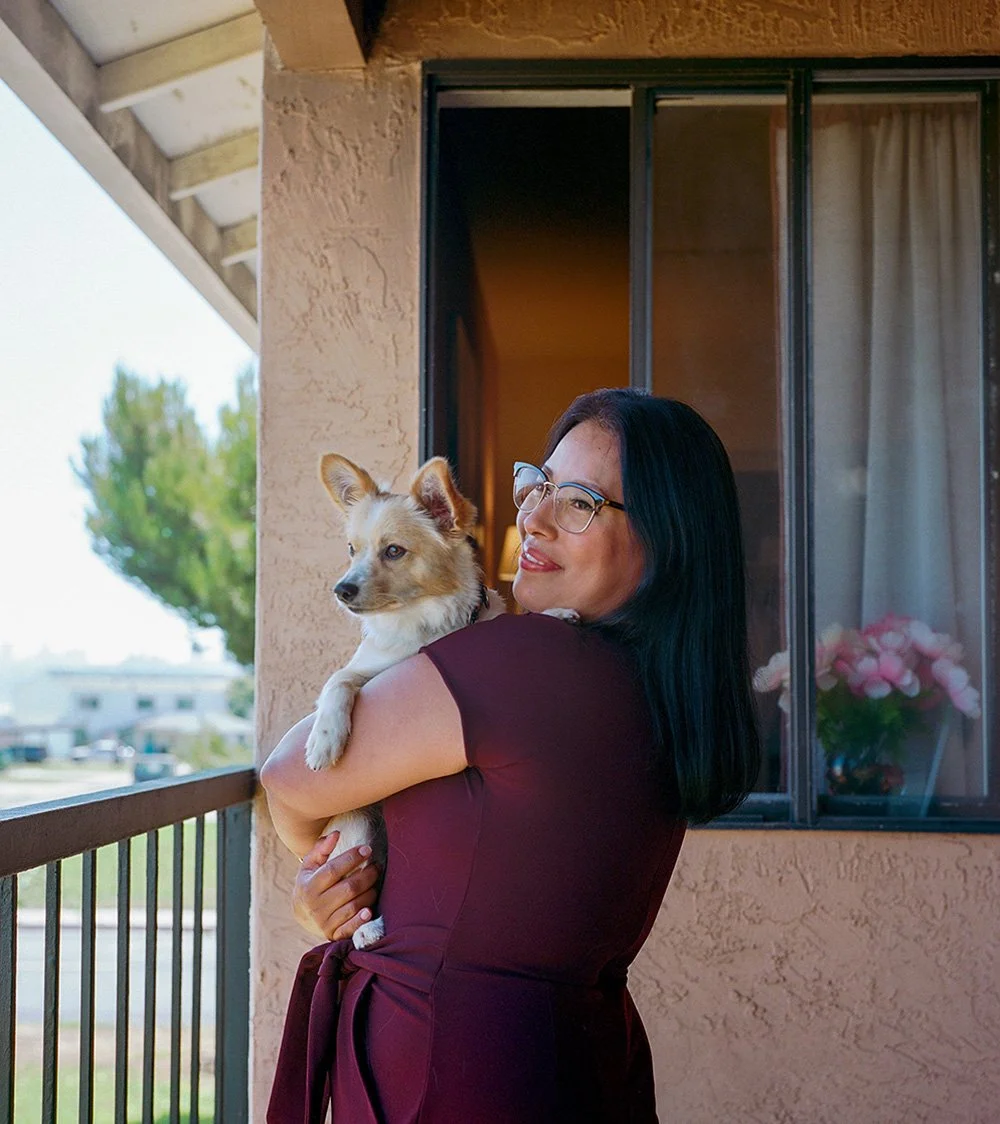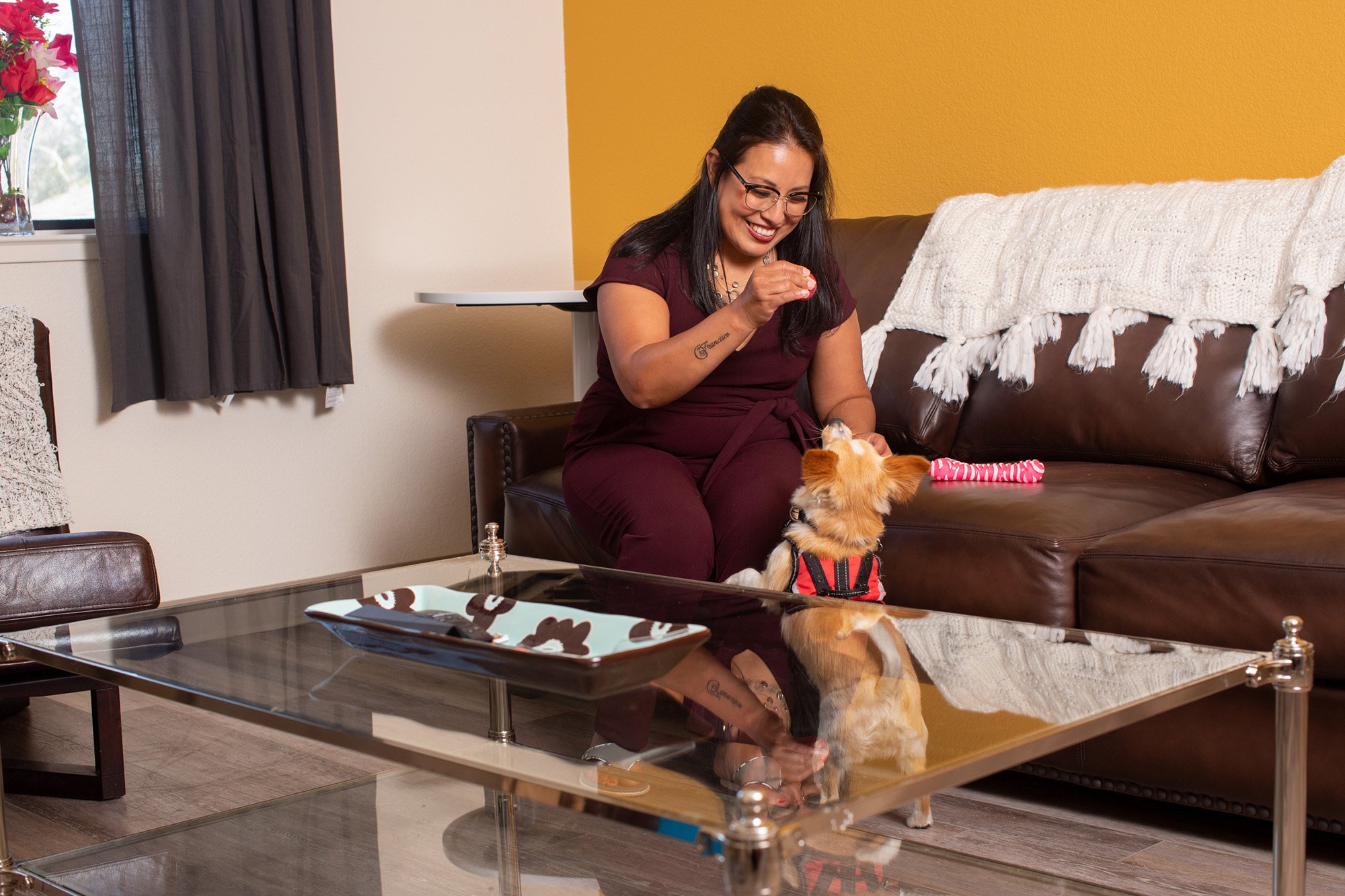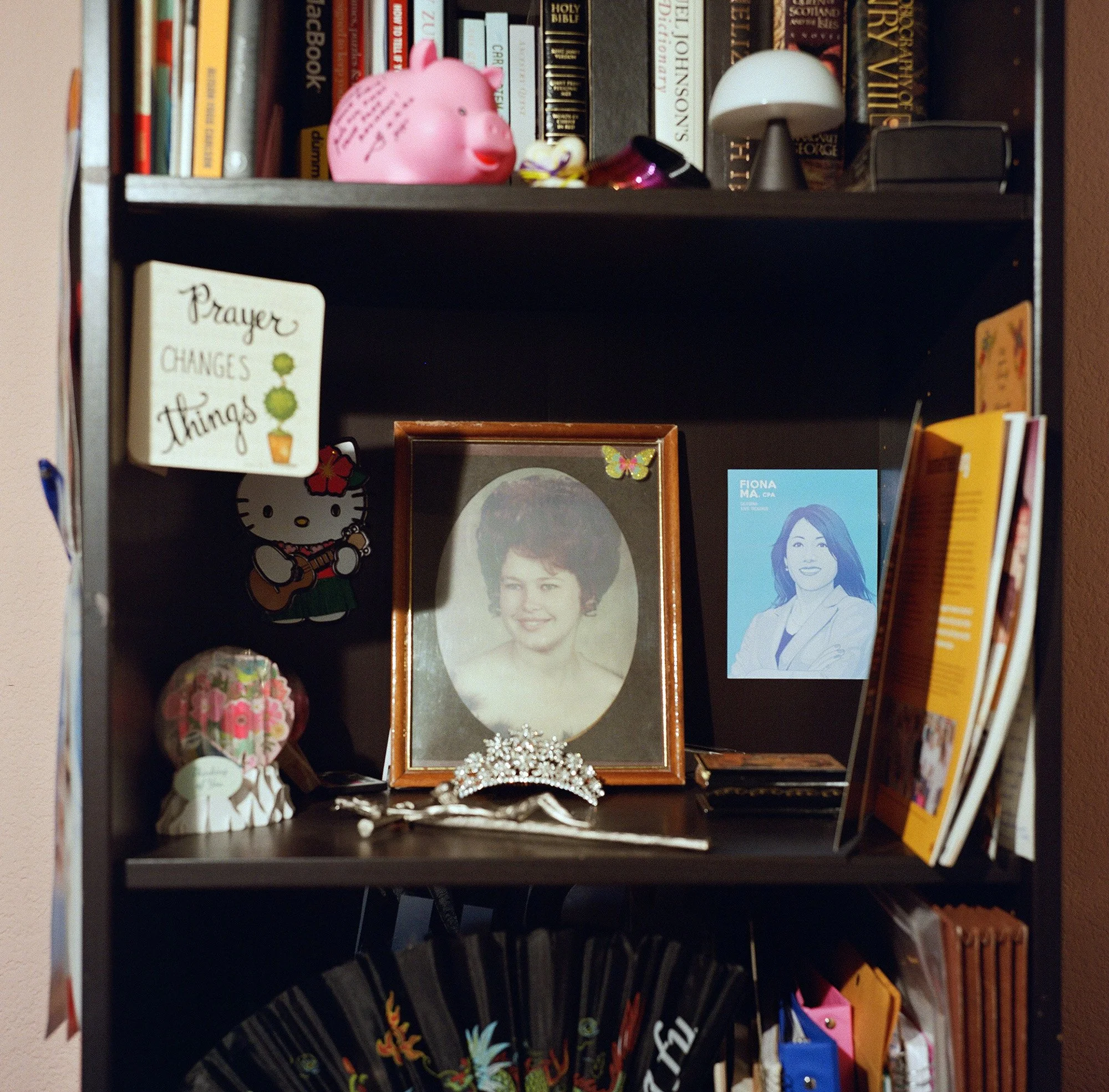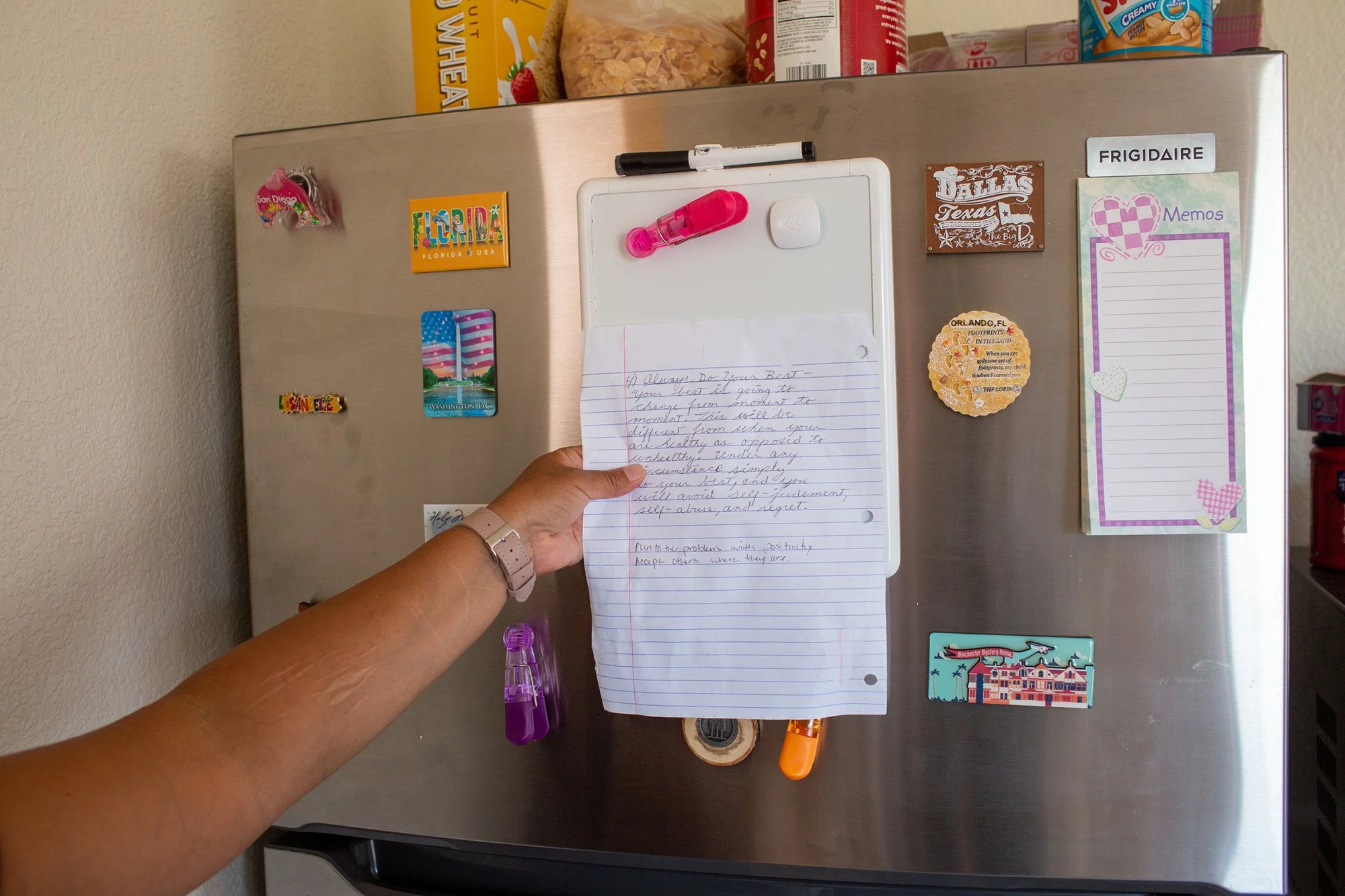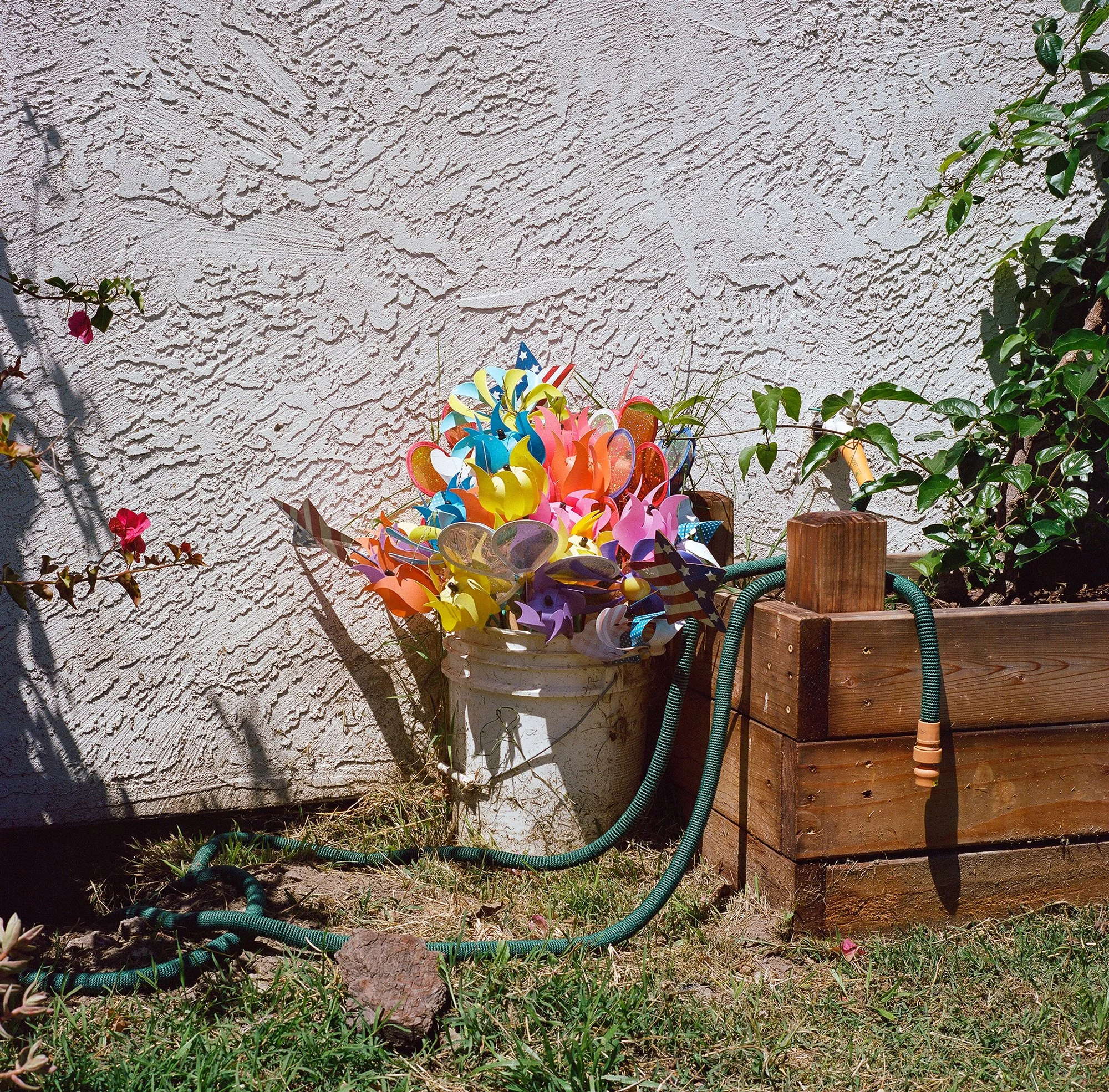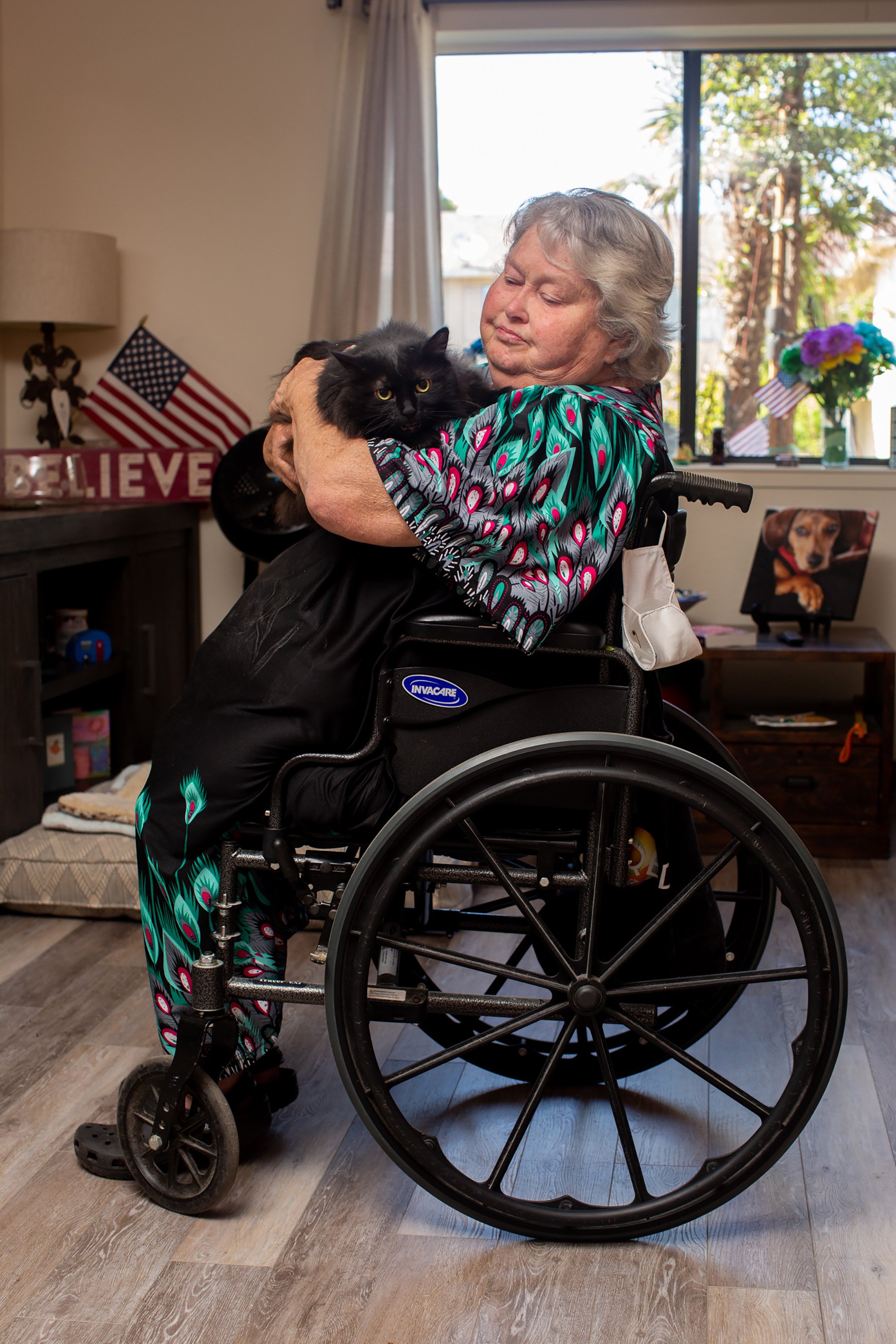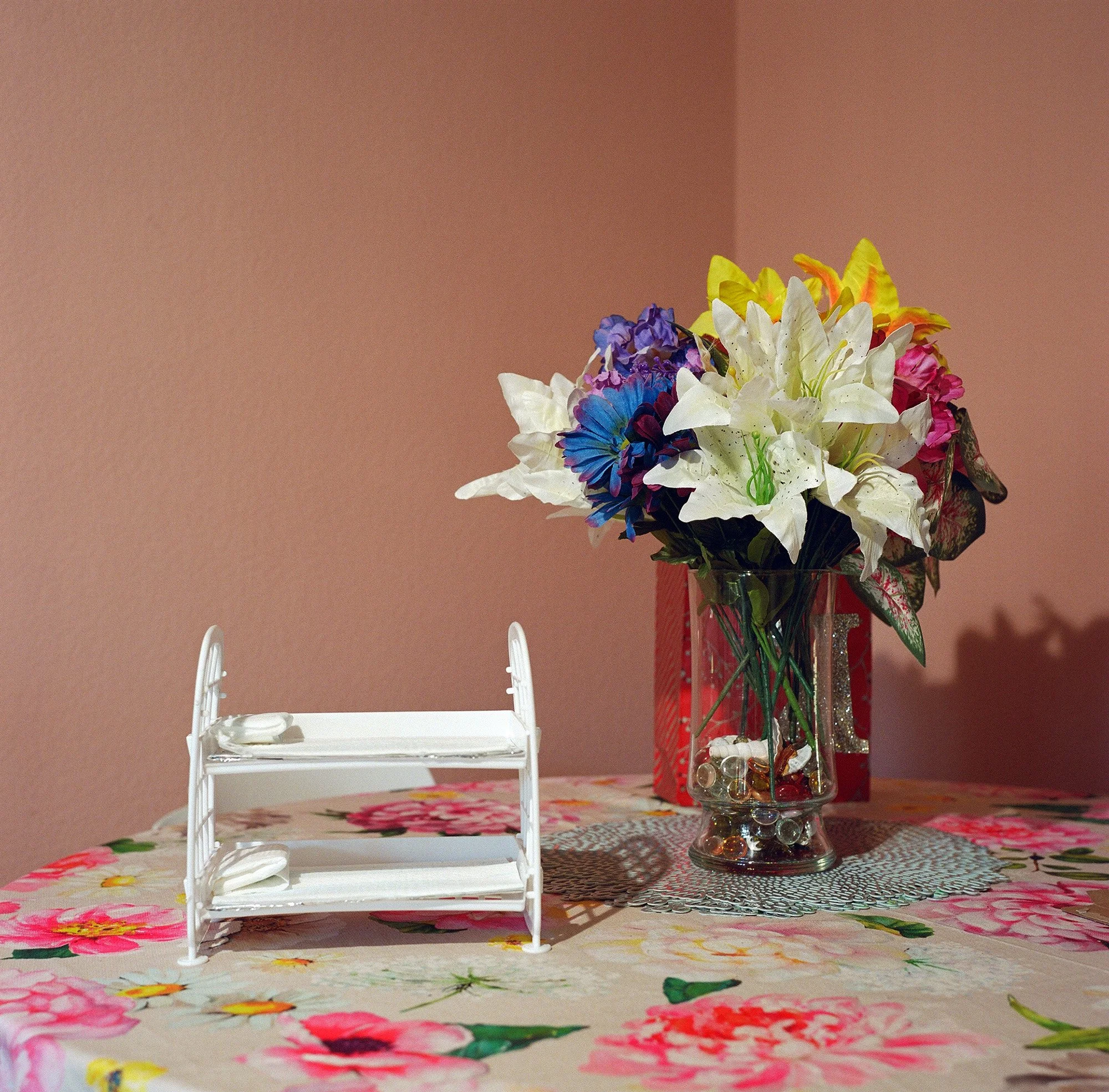Home Was a Nightmare, Then Home Was Prison. Finally Home Is Now a Refuge.
Published on Mother Jones, written by MARISA ENDICOTT
October 21, 2021
Nilda Palacios with her dog, Milo. Lizzy Myers
The first thing you notice when you walk into Nilda Palacios’ apartment is that it’s spotless—a blanket is carefully folded on the back of the couch, the floors shine, and cereals and supplements are meticulously arranged on top of the fridge and microwave.
Cleaning is therapeutic, the 38-year-old tells me. A warm and welcoming host in a light blue sweatsuit that accentuates her dark hair and dark eyes, and a shiny cross around her neck that matches her glossy nails, she shows me around while her Pomeranian-Chihuahua mix, Milo, follows. Despite the view of the San Francisco Bay Bridge from her back window, her favorite spot, she says, is really her bedroom—with its peach accent wall and purple curtains, a mirrored vanity that’s orderly but crowded with what she calls her “girly stuff.” “It’s homey,” she tells me.
It’s a room of her own—really the first one she’s had in at least two decades. “When I first got the keys to this apartment, I couldn’t believe it,” she says. “We haven’t had keys in forever. I had to learn how to open the door and then how to get in the house.”
Nilda Palacios in her living room. “It gives me a way of feeling comfortable, to be here all the time,” she says. Lizzy Myers
The “we” in this case is Palacios and the three other women who recently become her neighbors. They have all spent much of their lives in prison. But now they live at Home Free, a six-plex on Treasure Island, in the San Francisco Bay, that is a novel transitional housing program for women who share a complicated history: survivors of domestic abuse or trafficking who’ve served long sentences for serious crimes committed against or at the behest of their abusers. These experiences have created a complex web of shared trauma—the abuse, the crimes, the prison system, the reentry—that Home Free aims to untangle.
“I can’t believe that programs like this exist for people like us. I feel safe,” says Palacios, who is the youngest of Home Free’s residents; the oldest is 86. Despite their many differences, she explains, “this is a community here that we all have something in common.”
[Listen to Palacios talk about the personal touches she added to make it feel like home 🔈]
It’s a population that has long been overlooked or ignored—in part because the entire criminal justice system has always been designed with men in mind, even as the number of women in prison has soared in recent decades. Now, this specific community of women is seeing increasing, though still limited, opportunities for release, due to trickling criminal justice reforms and commutations, and an evolution in how we understand the links between trauma and crime. But with few resources at their disposal and little systemic support after long sentences, they are largely unsupported as they return to a completely changed world.
“Somebody might not think grass or trees is important, or it’s not that significant. To us, it’s the world.”
“We owe them service and dignity and second chances, whether it’s a small population or not,” says Sunny Schwartz, co-founder of Home Free and a prominent advocate for criminal justice reform in California. “They can still have impact. They can still effectuate change in their own right. As a society we need to do much, much better.”
All of this is why every aspect of Home Free, from the greenery out front to the bright paint in the bedrooms to the two-ply toilet paper (a luxury unheard of in prison), is deliberate and intentional—and a drastic departure from typical reentry environments. “Somebody might not think grass or trees is important, or it’s not that significant,” Palacios says. “To us, it’s the world.”
But beyond the careful aesthetic choices, the program’s true differentiator is the central focus on restoring autonomy—something denied to many of these women long before prison. “This environment is so conducive to creating a sense of normalcy that they’ve not had for a long time,” says Velda Dobson-Davis, a retired chief deputy warden of a women’s prison in California. “It’s just a wonderful thing to see that someone realizes that these women need the opportunity to live this way—to have a home that is not just clean and sterile, but is homely, inviting, comfortable.”
Prison was incredibly difficult for Palacios; she attempted suicide three times. “I lost who I was,” she says. Lizzy Myers
Palacios has been at Home Free since last fall. It was a long journey to get here. As a kid, she was sexually abused at home and at school. She tried to escape into a relationship, which turned abusive. Then, at 17, she was sentenced to 27 years to life after killing her partner during an altercation. Prison was incredibly difficult for Palacios; she attempted suicide three times. “I lost who I was,” she says. “Every day I had nightmares. I couldn’t sleep. I was restless. I was dealing with depression. I wanted it to end.” Eventually, she decided she wanted to make it through, pursued a degree, and started working as a peer counselor in health education. Finally, in 2017, after 17 years—half her life—she was released.
[Listen to Palacios describe the challenges of her life in prison 🔈]
But the challenges continued on the outside. The first housing facility she went to shut down abruptly, and she was left to fend for herself. She didn’t have enough money for rent, and she didn’t want to get into another relationship just to put a roof over her head. “I struggled a lot, and I stayed in my car,” Palacios says.
Home Free became a lifeline. It’s where she’s finally found a stable space and a home and a community. “To come home to quiet, not have to fear,” Palacios says, “that has established a lot of peace. Even the TV or having music or cleaning…I know that in some essence that has helped me. It gives me a way of feeling comfortable, to be here all the time.”
If she feels sad or lonely, she hangs out with the other residents or the program coordinator; she often helps her neighbors with chores, like cleaning their windows or grocery shopping. “I feel a connection because we all know the challenges we’ve been through inside and the limitations we had,” Palacios says. “Being around them, it cracks me up. It makes me feel like we all understand and enjoy what freedom is about.”
Before Rosemary Dyer, now 69 years old, became the first resident to move into Home Free last November, she spent 34 years in prison for killing her abusive husband.
For years, she had endured psychological and physical torture at his hands. He had threatened to put her in the “hole,” a grave dug on their property that he forced her to clean out every week. During one vicious attack in 1985, he sodomized her with a gun. “I begged him to pull the trigger,” she tells me recently. “I knew he wouldn’t. That would put me out of my misery. That would take all his fun away.” That night, when she was able to get the gun, she killed him.
When Rosemary Dyer first came to Home Free, she couldn’t believe it. “It’s really, really happening. Confirming it is amazing.” Lizzy Myers
But Dyer’s trial did not include expert testimony on her abuse and its effects. Evidence and consideration of “battered woman syndrome”—a pattern of signs or symptoms displayed by someone who is suffering persistent abuse—was not deemed scientifically legitimate or relevant in court at the time. So, in 1988, when she was just in her 30s, she was sentenced to life without the possibility of parole.
Starting around that time and in the following years, researchers, doctors, and lawyers began to pay more and more attention to the connection between abuse and criminality. Research increasingly showed that abuse and trauma, especially when they’re prolonged or starting at a young age, have links to PTSD, depression, heightened fight-or-flight impulses, and greater odds of interaction with the criminal justice system (systemic racism and classism compound the latter).
Expert testimony on battered woman syndrome became expressly admissible in court under California law in 1992; by 2000, it was admissible in 39 states. Battered woman syndrome put expert testimony “in a framework that seemed more palatable to some judges who were used to dealing with quote unquote hard science,” says Cindene Pezzell, legal director for the National Clearinghouse for the Defense of Battered Women.
“The criminal legal system is set up to measure harm in a way that’s asking whether or not something happened and not necessarily why it happened or is it going to happen again or how can we put things into place to prevent it from happening in the future.”
Today, battered woman syndrome—first developed in the 1970s on the heels of the 1960s feminist movement—is often viewed as an outdated and limiting concept. For one, on top of being gender exclusionary, experts point out that the framing as a “syndrome” is pathologizing and can be unnecessarily stigmatizing. Moreover, people respond to intimate partner violence in a wide variety of ways dependent on their individual circumstances and life experiences that don’t fit neatly into a prescribed set of symptoms or reactions. It “has always been a bit of an inaccurate and problematic framework, but it did open doors,” Pezzell says. That open door has enabled the overlap between intimate partner violence and the carceral system to become increasingly clear over the past couple decades. Though data is limited, research suggests that when women are condemned to long sentences for violent offenses, abuse is a frequent motive for their crime. One California state prison study from the early 2000s found that 93 percent of the women who had killed their significant others had been abused by them, and 67 percent of these women indicated the homicide occurred in an attempt to protect themselves or their children. The Stanford Criminal Justice Center is currently undertaking a three-year national research project to quantify how many women are in prison for killing their abusers; they believe the number will be in the thousands out of the roughly 12,000 women serving sentences for homicide in state prisons.
When Rosemary Dyer first came to Home Free, she couldn’t believe it. “It’s really, really happening. Confirming it is amazing.” Lizzy Myers
Yet even as our understanding of the connection between trauma and criminality has evolved, the system has not yet caught up. “The criminal legal system,” Pezzell argues, “is set up to measure harm in a way that’s asking whether or not something happened and not necessarily why it happened or is it going to happen again or how can we put things into place to prevent it from happening in the future.” In fact, courts continue to hold onto outdated views on domestic violence and the cycle of abuse, and juries rarely find abuse justifies violent retaliation. An analysis conducted by the New Yorker of justifiable homicides between 1976 and 2018 found that men who killed other men were 10 percent more likely to receive that ruling than women who killed men. These types of misconceptions have contributed, at least in part, to the explosion of the national incarceration rate for women—who are disproportionately Black and Latinx—in recent decades. And one in 15 of them are serving a life or virtual life sentence.
Still, the country’s prison systems overwhelmingly ignore the needs of women. “The system is set up for and by men,” says Amy Fettig, executive director of the Sentencing Project, a national research and advocacy organization working toward reducing criminalization and extreme punishment. “Women are an afterthought in our criminal justice system, and they suffer for it.” For instance, a majority of women in state prisons have children under 18, but everything about how the prison system is structured—from remote locations to inhospitable and limited visitations—makes it incredibly hard for mothers to stay connected with their children. Moreover, gender-specific medical care, mental health treatment, and trauma support, as well as vocational and educational programming, fail to meet demand. Dyer, for one, had trouble getting treatment for her breast cancer behind bars, and it eventually spread to her lymph nodes. Last December, Palacios found out she was at high risk for breast cancer and chose to get a double mastectomy—a condition she feels could easily have been missed or inadequately treated if she were still in prison. “I feel so joyful because I got the option to make that decision,” says Palacios, who as a peer educator in prison was always counseling women to do regular self–breast exams. “Inside prison, I watched so many of my peers die because of cancer.”
For women who have survived abuse, the prison setting can be especially damaging. The violent and controlling environment and standard correctional practices like shackling—not to mention well-documented harassment and sexual assault by staff—have the dangerous power to retraumatize. “Pretty much everything about incarceration mimics an abusive relationship,” Pezzell says. “You don’t even own your body when you’re incarcerated, and for a lot of victims of intimate partner violence, they don’t feel like they own their body either.”
Over time, California has taken sporadic steps to right outdated thinking about abuse and criminality in the legal system. Some of these changes are a direct result of advocacy by women who themselves were serving long sentences for crimes committed against or at the behest of an abuser. In the late 1980s, Brenda Clubine—who was serving a 15-years-to-life sentence in the state for killing her abusive husband—spearheaded the first abuse support group from behind bars where women could gather to help each other process their trauma and learn to break cycles of violence, advise one another on legal strategies, and even launch legislative reform campaigns. When Clubine got to prison she was shocked to find out how many women shared her experience, and she fought for three years to get the prison bureaucracy to finally approve her group, Convicted Women Against Abuse. The group would come to play a key role in statewide clemency campaigns for abused women and the legal reforms to come.
“Here were all these women that were stuck in jail. It could have been my mother, my grandmother that grew up in abusive situations, households, but would never say anything.”
After Clubine’s release in 2008, she continued her advocacy efforts, working with then–California Assembly member Fiona Ma, who was serving on the Public Safety Committee and as chair of the state legislature’s Select Committee on Domestic Violence. Ma, who is now California’s state treasurer, first got involved in intimate partner violence advocacy years earlier when a San Francisco woman who’d repeatedly reported her abuse was brutally murdered by an ex-boyfriend. Clubine connected Ma with others from her support group inside—including Rosemary Dyer. When Ma heard their stories, she felt compelled to act. “Here were all these women that were stuck in jail. It could have been my mother, my grandmother that grew up in abusive situations, households, but would never say anything,” Ma remembers thinking.
She soon introduced two bills: The first expanded the ability of people convicted before consideration of abuse was permitted at trial to petition the court to consider such evidence; the second allowed for abuse that survivors suffered to be given more weight at parole board hearings. Given opposition from law enforcement and district attorneys, Ma’s legislation, known as the “Sin by Silence” bills, failed at first, but were passed into law in 2012. This built upon landmark legislation passed several years earlier that first opened the door for survivors to challenge their original convictions. At last count, these bills together have helped nearly 90 women win their freedom.
This novel collection of laws was an important step forward—but they failed to address another huge problem. Reentry housing is required after people serve long sentences, yet space and options are limited, and programs mostly cater to substance abuse and people who’ve served shorter stints. People who don’t fit that mold often end up without a lifeline, and it can be particularly hard on formerly incarcerated women, who are even more likely to face unemployment and homelessness than formerly incarcerated men. “Although we spend billions on our correctional system, we spend a relatively small amount of both time and money on reentry, which is arguably where our priority should be,” Fettig says. “Too many of the resources have been used to not support people to succeed, but to catch people when they fail.”
Cleaning is therapeutic, Palacios explains in her hyper-organized kitchen. Lizzy Myers
Transitional housing programs are typically strict—often banning cell phones, limiting visitors, setting early curfews, and using the looming threat of reincarceration to enforce rules. The environment can be chaotic, with multiple people to a room. Like prison, this too can recreate or reinforce cycles of abuse. “To get out to someplace who makes you program from 6:30 in the morning to 9 o’clock at night, that’s torture,” says Susan Bustamante, who was released in 2018 at 63 years old after serving over 31 years in prison for the murder of her abusive husband. “You’re supposed to be in freedom. But to have the same structure that you just came out of, it messes with your mind.”
When we first spoke in 2019, Bustamante was stuck in a reentry facility she called her “nightmare house.” The director of the program was verbally abusive, which was triggering for Bustamante. She had mandatory all-day programming—much of which centered around sobriety and addiction recovery, despite the fact that she didn’t have a history of substance abuse. Residents couldn’t have cell phones or leave the property outside of attending prescribed support groups unless they had a job. Visits were limited to Sunday afternoons, which made it hard for Bustamante to see her daughters. “From 12 to 64, it’s been control by somebody else,” Bustamante told me then. “Being in this program, you don’t have a chance to use your own judgment to make a decision.”
“If you’re expecting to help somebody heal and get the foundation and the resources to build up a life for themselves again, and the way that you’re trying to do that is by taking away self-determination, it’s almost like a bad joke.”
“It’s just so ironic that that lack of control for so many people, the lack of options, are the very reasons that they intersected with criminality in the first place,” Pezzell says. “If you’re expecting to help somebody heal and get the foundation and the resources to build up a life for themselves again, and the way that you’re trying to do that is by taking away self-determination, it’s almost like a bad joke.”
This bleak reality pushed Ma in 2018 to connect with Sunny Schwartz, a seminal figure in criminal justice reform circles who founded Five Keys, an organization that provides educational and vocational classes and reentry services in jails and underserved communities throughout California. (Home Free is a project of Five Keys.) Despite spending decades developing reentry services throughout the state, mostly geared toward men, Schwartz was struck by the lack of consideration for abuse in the legal system and the dearth of services for women getting released after long-term incarceration. After talking to Ma, Schwartz quickly agreed to work on the problem and found partners in community advocates and formerly incarcerated women who were dedicated to creating a safe place for other women—and, crucially, a place tailored top-to-bottom to the specific needs of criminalized survivors, one intentionally designed to help them thrive in a radically different world.
Fundraising and finding a location proved to be a long and complicated process. Some sites were too expensive, while others weren’t accessible for people with physical disabilities (which was a must for residents like Dyer, who uses a wheelchair). Complicating matters further, some California counties don’t allow for multiple formerly incarcerated people to live together in the same place. After more than a year of searching, Schwartz finally secured the complex on Treasure Island, not long before the pandemic hit. Throughout the long and winding process, Schwartz relied on help and advice from formerly incarcerated survivors, including Clubine, Bustamante, and Dyer. “They’ve been my advisers from day one,” Schwartz says. “I may have great ideas, but they may backfire. I want to talk to the people who it really matters to.”
In March of last year, Dyer’s sentence was commuted by the governor because of her “demonstrated commitment to rehabilitation and self-improvement.” Ma picked her up from prison on the day of her release. A few months later, on a windy July day, Dyer got to see her future home for the first time as masked volunteers joined the construction team to kick off work on the about-to-be-gutted apartment complex. “I didn’t want to miss this for the world,” Dyer told me, sitting in her wheelchair and sunhat on the sidewalk, watching everyone at work. “It’s happening. It’s really, really happening. Confirming it is amazing.” She picked out a room on the bottom floor she liked. “I’m just thrilled to death that it has a window. Got to have a window,” she said. “I think it’s part of the freedom thing.”
[Listen to Dyer reflect on her journey since leaving prison 🔈]
Almost every aspect of the physical space at Home Free was designed with the women in mind. A team of professionals from a local design firm, students from a nearby art school, and workers from a city-sponsored construction program donated their time, working to completely redesign and rehabilitate the apartment complex. They met with formerly incarcerated survivors to find out what would be important to them, like greenery and avoiding colors and modern design schemes that reminded them of prison. That’s how the apartments ended up with colorful accent walls in warm yellows and soft peaches. At the building’s entrance, pink, blue, and orange planter boxes each have different trees growing to represent the diverse and unique women who will come through Home Free’s doors.
Pink, blue, and orange planter boxes at the building’s entrance each have different trees growing to represent the diverse and unique women who will come through Home Free’s doors. Lizzy Myers
Everything from the greenery to the furniture and cutlery to the bright colors throughout the Home Free space are the result of deliberate and intentional choices. Lizzy Myers
They converted one of the ground-floor apartments into a common room. It’s snug, simply furnished with a couple chairs, a bench, and a comfy navy couch—an easy set up for a Zoom meeting one Thursday afternoon this spring. As eight women gathered, Beatriz Vazquez, community programs manager for La Casa De Las Madres, an organization that works with domestic violence victims, appeared on a big screen. She started the session—“Healthy Relationships 101”—by asking the attendees a series of “myth or fact” questions about abusive relationships. She went over different forms of control, like when an abuser tries to undermine a partner’s academic or professional success with tactics like “deliberately starting an argument before an exam, work, project deadline, or presentation.”
“My husband literally burned my books one time because he said I was caring more about my classes than I was him,” one woman responded. “One of the things he said was, ‘When you go to school, all you’re trying to do is find somebody better than me’…I wanted to tell him if I ever get out of this relationship, I don’t want another one.”
At the end of the hour, Vazquez asked what they’d like to cover in future sessions. Women suggested “healthy friendships” and “relationships over 50.” All Home Free’s programming is based on what the women want to learn and what they want to do. Understandably, a lot of it centers on unpacking trauma. In addition to the options of group and individual counseling, residents can reach staff at any time for emotional support or accompaniment for things that might be overwhelming at first, like learning to catch the bus.
Programming, though, is expansive. Classes focus on the practical and financial skills which are too often lacking for these women, often in their 60s or older. Dyer, for instance, had never had a cellphone and had no idea what an internet search engine was. She had no credit, and she discovered that the Social Security Administration didn’t think she existed. Others, like Palacios, are further along, though she still needs help in reaching her next goal: saving up for a permanent home for her and her mom. She recently purchased a car and has been researching cryptocurrency investment. At a class on personal finance, Palacios beamed as the financial coach gave her a nod for progress on her credit score and reassured Dyer that they’ll work to build hers up. “We have issues that nobody else has. We’ve been told for so many years by our abusers how stupid we are and how worthless we are. And sometimes, you get told that enough, you believe it,” says Dyer.
When Dyer first got out of prison, she’d never had a cellphone, and the Social Security Administration didn’t think she existed. Lizzy Myers
Autonomy is a central tenet of Home Free’s structure. Every woman has their own room in one of the five two-bedroom apartments, and there is also a lot of free time. The women can have cellphones and decorate their apartments and have visitors. “Especially as a survivor, they need the ability to know that they can make decisions on their own and make good decisions,” says Kelly Savage-Rodriguez, a program coordinator with the California Coalition of Women Prisoners, a grassroots prison abolition organization, who is also a formerly incarcerated survivor of abuse. “A lot of survivors second guess themselves and don’t know that they can do it because they’re beat down so much emotionally, as well as physically.”
This, in fact, was something the women advising Schwartz emphasized again and again. “These are women who have been programmed. They have been locked up and been told what to do their entire life both by their abuser, as well as by the system, and the last thing we want to do is replicate any policy procedure of an institution,” Schwartz says. “It’s a balance. Of course, we have rules, of course we have boundaries, of course we’re creating safety, but it’s not a dictatorial thing.”
This immense amount of work and care built into Home Free’s small program is unusual and hard to replicate at scale, but Schwartz sees the investment as indispensable to the project’s success. “The problem with institutions, among other things, is that they treat everybody as if they’re the same,” says Schwartz. “They’re dealing with thousands and thousands of people. We’re not. We have and should deal with people on a case-by-case basis of what their needs and struggles and wants are.”
“It’s so rewarding to be able to look at yourself in the mirror and say, ‘I like you.”
Fettig, who is not associated with Home Free, echoes this sentiment. “I think you have to do it small in order to be effective, especially when you’re dealing with people with a lot of need,” she says. “When you’ve got so many women who are subject to such long sentences, by and large a lot of them are coming home after being gone for a while. Our prison population is getting older and older. This presents challenges that we have never faced in our history because of our extreme sentencing. This is going to be a new challenge that we have to face, and we have to do it effectively.”
“Quite frankly, every jurisdiction needs something like this,” she adds.
And that’s the idea: to make Home Free a model. Schwartz is currently fundraising and looking at residences in the Los Angeles area for a second Home Free location.
When Home Free opened its doors last November, a few others moved in along with Dyer, including Palacios—though the pandemic, along with the difficult pathway to release from prison more broadly, have slowed the process of filling the house with residents. At my last visit in April, six of the 10 rooms remained empty. But Tammy Garvin, who works as a residential coordinator and reentry coach for Home Free, had identified 66 incarcerated women who may be eligible for the program when they’re released. As of mid-October, two more women were expected to be moving in in the next couple of weeks.
Garvin is also a survivor. She was serving life without parole before her sentence was commuted in 2018. She was sex-trafficked at a young age, and after her trafficker killed one of her clients, she was charged with the crime under the felony murder rule, which allows for a person who is only indirectly involved to be charged even if they didn’t commit the act. Garvin was a domestic violence group facilitator in prison, so she’s well equipped for her role now. “It means a lot to me to be able to help,” Garvin says. “If you have someone who’s been there to be able to help the ladies, it makes a big difference.”
And that’s the key. Home Free is the culmination of a decades-long struggle by women to be seen and supported by a system that has condemned and ignored them. Women like the residents in Home Free spent years inside prison processing their crimes and trauma through support groups that didn’t exist until incarcerated survivors—including some of the women now supporting and living in Home Free—created them. On the outside, they’ve continued that work, growing into their power individually and as a community. Palacios is a case worker at a mental health clinic and wants to get a degree in sociology. Bustamante, who now lives with her daughter in Southern California, recently got her driver’s license and drove up in May to celebrate her 66th birthday with the Home Free team; she hopes to work with the battered woman’s group she helped Brenda Clubine build inside prison, once COVID protocols are adjusted, and has also been part of the reform movement to drop life-without-parole sentencing and a campaign pushing a bill to further amend the felony murder rule that recently passed the state senate. Dyer regularly does talks over Zoom with domestic violence awareness organizations, and she’s working on a memoir that she started writing in prison.
Local designers helped create spaces that feel nothing like an institution, with colorful accent walls in warm yellows and soft peaches. Lizzy Myers
“I get so much out of being of service to others,” Palacios says. “And helping them has helped me.”
Dyer, too, marvels at how far she’s come and what’s she’s accomplished since she first joined Clubine’s support group all those years ago. “When I got arrested, I would not have been talking to you like this. You would not have been able to hear me…I barely whispered. And that’s because I was never allowed to talk. I was never allowed to laugh, I was never allowed to sing, I was never allowed to whistle,” she told me in a conversation shortly after her release from prison. “It’s so rewarding to be able to look at yourself in the mirror and say, ‘I like you.’”
“When he was alive, I never looked in the mirror because I never knew who that person was.” The first time she did, she stood there staring. “I’m just getting to know me.”
More recently, about a year after she’d started her life on the outside, we talked on the lawn of her new home on a sunny afternoon. Dyer, in a bright floral muumuu, was assured and laughed easily. “I’ve had my own personal challenges after coming here, but I’ve gotten over them, gotten past them. There is nothing that I can’t accomplish.”

